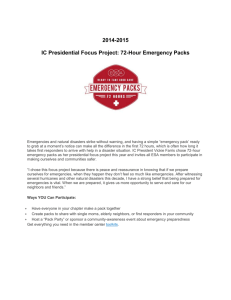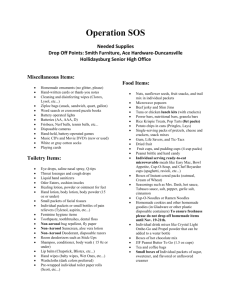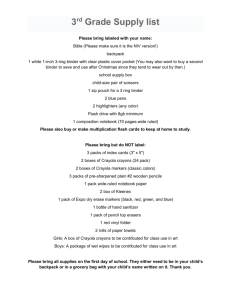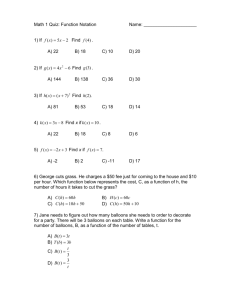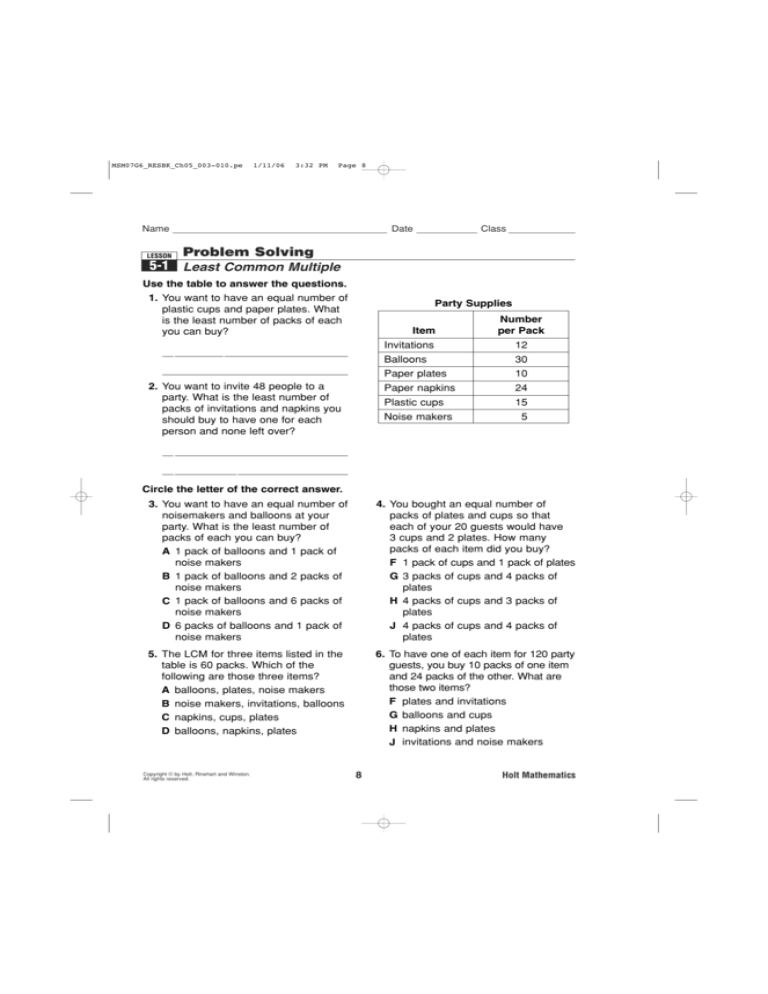
MSM07G6_RESBK_Ch05_003-010.pe
1/11/06
3:32 PM
Page 8
Name
LESSON
Date
Class
Problem Solving
5-1 Least Common Multiple
Use the table to answer the questions.
1. You want to have an equal number of
plastic cups and paper plates. What
is the least number of packs of each
you can buy?
Party Supplies
Item
3 packs of plates and
2s
2. You want to invite 48 people to a
party. What is the least number of
packs of invitations and napkins you
should buy to have one for each
person and none left over?
Number
per Pack
Invitations
12
Balloons
30
Paper plates
10
Paper napkins
24
Plastic cups
15
Noise makers
5
4 packs of invitations and
2 packs of napkins
Circle the letter of the correct answer.
3. You want to have an equal number of
noisemakers and balloons at your
party. What is the least number of
packs of each you can buy?
A 1 pack of balloons and 1 pack of
noise makers
B 1 pack of balloons and 2 packs of
noise makers
C 1 pack of balloons and 6 packs of
嘷
noise makers
D 6 packs of balloons and 1 pack of
noise makers
4. You bought an equal number of
packs of plates and cups so that
each of your 20 guests would have
3 cups and 2 plates. How many
packs of each item did you buy?
F 1 pack of cups and 1 pack of plates
G 3 packs of cups and 4 packs of
plates
H 4 packs of cups and 3 packs of
plates
J 4 packs of cups and 4 packs of
嘷
plates
5. The LCM for three items listed in the
table is 60 packs. Which of the
following are those three items?
A balloons, plates, noise makers
B noise makers, invitations, balloons
嘷
C napkins, cups, plates
D balloons, napkins, plates
6. To have one of each item for 120 party
guests, you buy 10 packs of one item
and 24 packs of the other. What are
those two items?
F plates and invitations
G balloons and cups
H napkins and plates
J invitations and noise makers
嘷
Copyright © by Holt, Rinehart and Winston.
All rights reserved.
8
Holt Mathematics
MSM07G6_RESBK_Ch05_083-102.pe
1/11/06
3:33 PM
Page 84
Problem Solving
5-1 Least Common Multiple
Challenge
5-1 Moons Over Neptune
LESSON
LESSON
Use the table to answer the questions.
We measure one month by our moon’s orbital period, or the time it
takes the Moon to travel once around Earth, which is about 30 days.
But what if you lived on Neptune? It has 8 moons! How could you
pick just one moon to measure your months? One possible solution
is to calculate one month based on when two of Neptune’s moons
are in conjunction at some arbitrary starting point in the sky, or appear
to be in the same place in the sky. The diagram below shows some
of the moons you could use to measure your months on Neptune.
1. You want to have an equal number of
plastic cups and paper plates. What
is the least number of packs of each
you can buy?
Party Supplies
3 packs of plates and
2 packs of cups
2. You want to invite 48 people to a
party. What is the least number of
packs of invitations and napkins you
should buy to have one for each
person and none left over?
Galatea: Orbital Period about 10 hours
Number
per Pack
Item
Invitations
12
Balloons
30
Paper plates
10
Paper napkins
24
Plastic cups
15
Noise makers
5
4 packs of invitations and
Naiad: Orbital Period about 7 hours
2 packs of napkins
Despina: Orbital Period about 8 hours
Circle the letter of the correct answer.
Larissa: Orbital Period about 13 hours
Neptune
Proteus: Orbital Period about 26 hours
Use the diagram and least common multiples to complete
the chart below. For each row, write how long your month on
Neptune would be if you used those moons in conjunction as
the length of one month.
Neptune Moons to Use
Length of One Neptune Month
about 56 hours
about 26 hours
about 40 hours
about 104 hours
Naiad and Despina
Larissa and Proteus
Galatea and Despina
Despina and Proteus
Copyright © by Holt, Rinehart and Winston.
All rights reserved.
7
Holt Mathematics
3. You want to have an equal number of
noisemakers and balloons at your
party. What is the least number of
packs of each you can buy?
A 1 pack of balloons and 1 pack of
noise makers
B 1 pack of balloons and 2 packs of
noise makers
C 1 pack of balloons and 6 packs of
嘷
noise makers
D 6 packs of balloons and 1 pack of
noise makers
4. You bought an equal number of
packs of plates and cups so that
each of your 20 guests would have
3 cups and 2 plates. How many
packs of each item did you buy?
F 1 pack of cups and 1 pack of plates
G 3 packs of cups and 4 packs of
plates
H 4 packs of cups and 3 packs of
plates
J 4 packs of cups and 4 packs of
嘷
plates
5. The LCM for three items listed in the
table is 60 packs. Which of the
following are those three items?
A balloons, plates, noise makers
B noise makers, invitations, balloons
嘷
C napkins, cups, plates
D balloons, napkins, plates
6. To have one of each item for 120 party
guests, you buy 10 packs of one item
and 24 packs of the other. What are
those two items?
F plates and invitations
G balloons and cups
H napkins and plates
J invitations and noise makers
嘷
8
Copyright © by Holt, Rinehart and Winston.
All rights reserved.
Holt Mathematics
Puzzles, Twisters & Teasers
5-1 Math Abbreviation
Reading Strategies
5-1 Understanding Vocabulary
LESSON
LESSON
Draw a line from each pair of numbers to common multiples for
the numbers. Sometimes you will need to draw two lines from
the same pair of numbers.
Least means the smallest in size. The person with the least amount
of homework has the smallest amount of work to do.
Common means shared. You may have classes in common with
some of your friends.
When you have finished, you will see a famous math
abbreviation.
A multiple is the answer to a multiplication problem.
The multiples of 5 are the answers to multiplying numbers by 5.
155
96
(8, 12)
2 5 10 3 5 15 4 5 20
The least common multiple is the smallest multiple two numbers
have in common.
40
20
15
36
25
2
Follow the steps for finding the least common multiple of
5 and 10.
14
12
33
1. List the first 10 multiplies of 5.
(4, 5)
15
4
5, 10, 15, 20, 25, 30, 35, 40, 45, 50
27
56
2. List the first 5 multiples of 10.
10, 20, 30, 40, 50
(6, 9)
18
74
24
15
(4, 10)
3. What multiples do 5 and 10 have in common?
10, 20, 30, 40, 50
4. Write the smallest multiple that 5 and 10 have in common.
5. What is the least common multiple of 5 and 10?
10
10
6. To find the least common multiple of two numbers, what is the first thing you
should do?
List the multiples of both numbers.
7. What should you do next?
Compare the multiples they have in common.
8. How do you know which of the common multiples is the least common multiple?
It is the smallest multiple.
Copyright © by Holt, Rinehart and Winston.
All rights reserved.
9
Copyright © by Holt, Rinehart and Winston.
All rights reserved.
Holt Mathematics
Copyright © by Holt, Rinehart and Winston.
All rights reserved.
84
10
Holt Mathematics
Holt Mathematics


